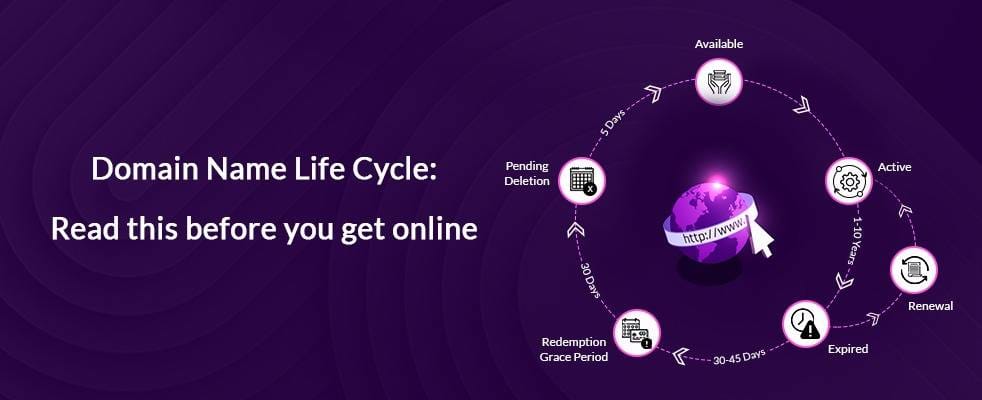
Domain Name Life Cycle: Life Of A Typical Top-Level Domain
When you registered your favourite domain, did you realize that you had entered a stage in that domain name’s lifecycle? Yes! Let’s have a look at it!
But, before going through the lifecycle let’s look at some important periods defined by ICANN. Note that these periods are counted in calendar days.
According to ICANN .net Registry Agreement: Appendix 7,
“A Grace Period refers to a specified number of calendar days following a Registry operation in which a domain action may be reversed and a credit may be issued to a registrar.
Relevant Registry operations in this context are:
- Registration of a new domain,
- Extension of an existing domain,
- Auto-Renew of an existing domain; and
- Deletion of an existing domain.”
| Grace Periods | Mentioned by | No. of Days | What happens in this period? |
|---|---|---|---|
| Add Grace Period | The Registry. | Typically within 5 days after you register your domain name. | During this period, you can get the domain deleted by contacting your registrar and receive a credit for the registration fee.
(Deletion charges may vary from registrar to registrar.) |
| Renewal/ Extend Grace Period | The Registry. | Typically 45 days after your domain expires. | During this period, you can renew your domain names without penalty.
(Renewal charges may vary from registrar to registrar.) |
| Auto-Renew Grace Period | The Registry. | Typically 45 days after the auto-renewal of your domain name | During this period, you can delete the auto-renewed domain and receive the credit for the domain renewal.
(Deletion charges may vary from registrar to registrar.) |
| Redemption Grace Period | The Registry. | Typically 30 days after Renewal Grace Period. | During this period, your registrar can restore your domain name after the expiry of Renewal Grace Period. |
So, now we have a basic idea of what Grace Periods are, let us understand the domain name life-cycle in detail. It is a short, sweet and simple life cycle of 5 stages.
Stage 1:
Registration or Renewal of the Domain name
This is the entry point of the cycle. This is where you visit Domain Resellers like QualiSpace or Registrars like us to book yourself a domain.
These are the general steps involved in the process:
- Checking the availability of the domain name
- Registration
- Payment
- Done and done! The domain name is yours.
As per ICANN’s regulations, you can register this domain for a period of 1 to 10 years. Once you register the domain name, it becomes active only for the period you have registered it for. Example: 1 year, 3 years, 10 years, etc.
Also, did you know that you could transfer your domain from one registrar to another registrar? Yes, you can! But only after a waiting period of the initial 60 days.
Stage 2: (30-45 Days)
Domain Name Expires, Renewal Grace Period Starts
If you don’t renew the domain name before the mentioned date, it will expire and enter the ‘Renewal Grace Period’. RGP varies from 30-45 days depending on the domain extension and the registrar. In this period, all the services you have been using with the domain name such as E-mails, website, sub-domains will stop working.
It is up to the registrar to either park or put the domain for auction. If you want to renew the domain, this is your final chance to do that without any penalty. If the domain is auctioned, you will have to bid for it!
Here is one more interesting thing that happens in the background!
During the Renewal Grace Period, if you check the status of the domain in the WHOIS database, you will be surprised to see that the expiry date is of the next year. It has been renewed for a year! But you did not do. Then how?
As the renewal period begins, the domain gets auto-renewed by the registrar at the registry side. The domain is just floating there in the redemption-list of the registry, hoping to be renewed by you. But, yeah, even if it is “renewed” you cannot use it. You will have to pay the price to renew it first.
Stage 3: (30 Days)
Renewal Grace Period Ends, Redemption Grace Period Starts
If you don’t renew the domain during the Renewal Grace Period, your registrar will delete it. Now the domain enters what we call as “Redemption Period”. The Redemption Period is 30 days. Even if the domain is generally deleted from the Registrar side, it still exists in the registry’s database. So, if you want, you can still renew it. But now the revised amount will be: Domain Renewal Price + Restoration Cost.
Stage 4: (5 Days)
Redemption Grace Period ends, Queued for Deletion
Once the Redemption Grace Period ends, you cannot get your domain back until it is back in the market. The registry will mark the status of the domain as “Pending Delete”. Now, the domain name keeps floating for 5 days at the registry in the ‘Delete Queue’ waiting to be deleted.
Stage 5:
The domain name is Deleted, Made available for registration
Once the long wait of 5 days ends, the domain finally gets deleted. Just like the usual queues in the algorithms, this queue will delete the domains in the list on the First-Comes-First-Served basis. All of the data associated with it such as websites, subdomains, E-mails, etc. will be lost.
Once it gets deleted, it will be back in the market for sale. It is ready to traverse the entire lifecycle once again.
If you lose your website, it becomes very difficult to build it again. Auto-renewal is a good practice as it eliminates the chances of missing the date.
If you want to know more, visit www.connectreseller.com.






